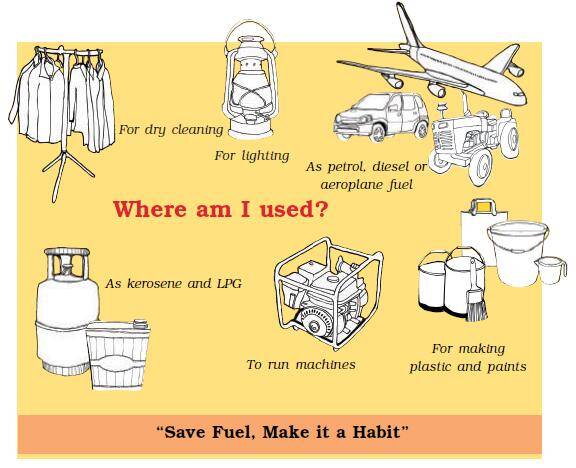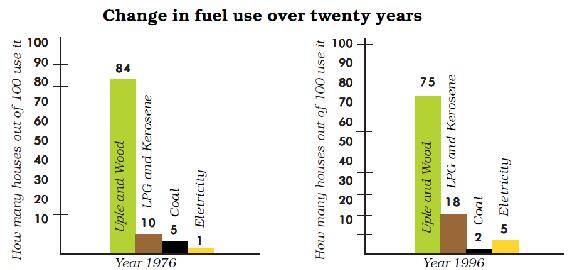GetStudySolution
Getstudysolution is an online educational platform that allows students to access quality educational services and study materials at no cost.
NCERT Solutions for class 5 E.V.S chapter 12 – AWhat If It Finishes
Back Exercise
Page No 111:
Question Look at the Picture :
- What are the different kinds of vehicles that you can see?
What do you think they need as fuel?
Which of the vehicles do you think give off smoke? Put a red mark on those.
Answer:
Disclaimer: This section aims to enhance the students’ imagination and observation skills. Considering the sustenance of this process, the answer to the questions has not been provided.
Question Tell:
- Do you ride a bicycle? If yes, where all do you go on it?
- How do you come to school?
- How do your family members go to work from home?
- What problems can we have from smoke coming out of vehicles?
Answer:
- Disclaimer: This question has to be answered by the students based upon their own experience. Hence, the same can vary from one student to another. Considering this, the answer to the question has not been provided.
- Disclaimer: This question has to be answered by the students based upon their own experience. Hence, the same can vary from one student to another. Considering this, the answer to the question has not been provided.
- Disclaimer: This question has to be answered by the students based upon their own experience. Hence, the same can vary from one student to another. Considering this, the answer to the question has not been provided.
- The smoke coming out from the vehicles can cause pollution of air. This polluted air can cause respiratory disorders in animals and human beings. The harmful substances present in smoke can also make rain water impure.
Page No 113:
Question Find out:
- Which states of India have oil fields?
- Besides oil, what else is found deep inside the earth?
Answer:
- India has oil fields in the states of Assam, Gujarat and Maharashtra.
- Besides oil, metals such as gold, silver, copper are found deep inside the earth.
Page No 114:
Question Write:
- What all can vehicles run on?
- What kinds of problems will we face, if the number of vehicles keeps on increasing? For example, more traffic on the road. Talk to your elders and write about it.
- Manju said, “Why doesn’t everyone use a bus?” What do you think, why don’t people travel by buses?
- Suggest some ways to deal with the problems arising out of the growing number of vehicles.
Answer:
- Vehicles can run on diesel, petrol, coal, CNG, electricity, etc.
- If the number of vehicles keeps on increasing we would not get space to move on the road. There would be more traffic jam on the road and everyone would run late for work. There would be more smoke coming out of the vehicles and then we would suffer from more breathing problems. There would be noise pollution all around.Disclaimer: This question has to be answered by a student based upon his own thinking and imagination. Hence, the same can vary from one student to another.
- People do not travel by buses for their own convenience. People love to travel in their own vehicles to save their time.
- Some ways to deal with the problems arising out of the growing number of vehicles are:
(i) We should avoid using private vehicles for traveling. Rather we should try to travel by bus.
(ii) If possible, we can live near our working place to reduce the need of moving out in vehicles.
Page No 115:
Question Find Out and Write:
How much oil? | Scooter | Car | Tractor |
How much petrol/diesel can be filled at a time? | |||
How far can it go on one litre of petrol/diesel? |
The rates of petrol are different in each city. The rates of petrol and diesel in Chennai are given here. Look at the table and answer the questions.
Oil | Rate of one litre in 2002 | Rate of in one litre 2007 |
Petrol | Rs 28 | Rs 47 |
Diesel | Rs 18 | Rs 33 |
- In ___ years the rate of petrol went up by ___ rupees. The rate of diesel increased by ___ rupees.
- What was the difference in the rates of petrol and diesel in the year 2007?
Answer:
- In 5 years the rate of petrol went up by 19 rupees. The rate of diesel increased by 15 rupees.
- (b) The difference in the rates of petrol and diesel in the year 2007 is Rs 14.
Page No 116:
Question See the poster and w:

- Where all is oil used?
- Where is diesel used? Find out.
Answer:
- Oil is used:
(i) For dry cleaning
(ii) For lighting
(iii) As petrol, diesel or aeroplane fuel
(iv) As kerosene and LPG
(v) To run machines
(vi) For making plastic and paints
- Diesel is used as fuel in vehicles such as cars, tractors, buses and trucks. It is also used in generators for electricity generation.
Page No 117:
Question Think and Discuss:
- What would happen if you don’t get petrol or diesel for a week in your village or town?
- Suggest some ways to save oil.
Answer:
- imagination and thinking ability. Considering the sustenance of this process, the answer to the same has not been provided.
- Some ways to save oil are:
(i) Using public transport such as buses and trains instead of private vehicles such as cars and bikes
(ii) Switching off the engines when we stop your vehicles at traffic signals
(iii) Using some other alternatives of energy such as sunlight (solar energy) that would last longer
Question Discuss:
- Have you ever collected dry wood or made cow dung cakes? How are they made?
- Do you know anyone who collects dry wood or leaves to be used for lighting a chulha?
- Who cooks food in your family? What about other families in your area?
If they cook food using wood or upla (cow dung cakes), what difficulties do they face due to smoke?
- Can Durga use anything else instead of wood? Why not?
Answer:
Disclaimer: This section comprises of questions which calls for the process of one’s own observation and gathering information. Considering the sustenance of this process, the answer for the same has not been provided.
Page No 118:
Question Tell from the Graph:

- In year 1976, out of 100 how many houses used uple and wood?
- Which was the fuel used the least in 1976?
- In 1976, LPG and kerosene were used in ______ houses and in 1996 this increased to______. This means that in twenty years their use increased by________%.
- Out of 100 how many houses were using electricity in 1996?
- Which fuel was used the least in 1996? What percentage of houses used it in the year 1976?
Answer:
- In year 1976, out of 100, 84 houses used uple and wood.
- Electricity as a fuel was used the least in 1976.
- In 1976, LPG and kerosene were used in 10 houses and in 1996 this increased to 18 . This means that in twenty years their use increased by 80 %.Hint: Increase in LPG and kerosene usage in twenty years = (18 – 10/ 10) × 100
- Out of 100, 5 houses were using electricity in 1996.
- Coal was used the least in 1996. 5% of houses used it in the year 1976.Hint: Percentage of houses using coal in 1976 = 5/ 100 × 100
Page No 119:
Question Find Out from Your E:
- When they were young what was then used to cook food at home?
In the past 10 years use of which cooking fuel has increased in your area? Use of which fuel has decreased?
Guess the use of which fuel would increase and which would decrease in the next 10 years.
Answer:
Disclaimer: This section aims at increasing the creativity of the students. Hence, the students are advised to do this section themselves.
Question What we have learnt:
- Imagine that a company has given you a chance to design a new vehicle like a mini bus. What kind of vehicle would you design? Write about it. Draw a picture and colour it.
- While making the design, who did you plan to take care of:
old people __________________
children __________________
those who cannot see? __________________
- Look out for news reports on oil. Cut these and make a collage. Put up a chart in your classroom. Also write your own views on these reports.
- Make a poster with a message on saving fuel. Write a slogan too. Where would you like to put up this poster?
Answer:
- Disclaimer: This section aims at increasing the creativity of the students. Hence, the students are advised to do this section themselves.
- Disclaimer: This section aims at increasing the creativity of the students. Hence, the students are advised to do this section themselves.
- Disclaimer: This section comprises of questions which calls for the process of one’s own observation and gathering information. Considering the sustenance of this process, the answer for the same has not been provided.
- Disclaimer: This section aims at increasing the creativity of the students. Hence, the students are advised to do this section themselves.